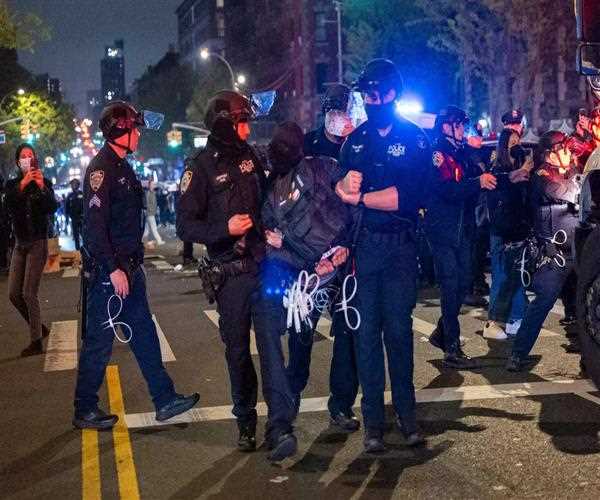Search here

02-May-2024 , Updated on 5/2/2024 7:26:40 AM
300 protesters from Columbia University and City College of New York were arrested. Why?
The recent police arrest of approximately three hundred protesters at Columbia University and City College of New York has led to a huge lot of media attention and created doubts about the need for having a huge police operation. Here's the series of events that took place and the explanations as to why these arrests came about.
Background of the Protests
These protests took place as a part of broader wave of protests sweeping through the US campuses, where students requested their universities to divest companies that supply Israel with the military gear. This movement was able to gain momentum due to the on ongoing conflict in Gaza where reports of serious human rights violations are documented. The protesters at the University of Columbia and The City College were of the view that the university was against the peace talks and the ending of these wars because of investments in the conflict.
The Night of The Arrests
On that matter, we have to note that about 300 students were arrested by the New York Police Department (NYPD) which were both inside and outside a building of the Columbia University. The NYPD's Chief of Department, John Chell, explained that, among the suspects, the college students from both Columbia University and City College, were part of a significant number of them. These arrests took place during the course of the protests that called for the universities to remove the agreements they had with Israeli organizations.
The Reasons for the police action
1. Alleged Violation of Laws and University Policy: According to the Commissioner of the New York City Police Department Edward A. Caban, attention was not only given but also buildings were forcefully entered; as such, Hamilton Hall was one of them. The authorities cataloged the events as growing beyond a simple protest, and implicated the trespassing, the criminal mischief and burglary details.
2. Concerns Over Safety and Order: New York City Mayor Eric Adams noted that several persons being involved who were outside the university community might have been adding gasoline to the blazing fire. It was stated that police department of New York was obliged to come in and intervene to prevent further disorder and to maintain all parties' safety.
3. University's Request for Assistance: According to the reports, it was alleged that the police intervened on request from Columbia University. The situation had gone out of the peaceful protest only and thus the police were requested to intervene. It cannot be said otherwise that his interaction was decisive when taking into account NYPD's reaction to the case.
Impact on Student Activism
This massive arrest of campus students leads to more crucial consequences for the future organizing struggles of students on campus. First, the response of the police and the legal procedures after the arrest of the protesters could turn new activists away or change the way protests are organized and conducted. Activists might need to conduct their activist activities differently to help ensure their safety and legality when it involves controversial political issues, like when they are holding demonstrations over them.
Legal and Ethical Considerations
Arrests of both activists and journalists raise critical legal and ethical questions from the perspective of the freedom of protest. To policymakers' debate on where the line should be drawn favoring order and respect for students' expression of opinions. This turns up the issues also about how and where to focus on making sure that all people who are on campus, including those who are not necessarily the members of the university community or even the campus, involved in the campus affairs, would not be involved in unlawful activities.
The Response and Upheavals
Reactions to detentions have ranged from elation to unease depending on interplay of historical and social factors. Many of the protesters and the audience are outraged, believing that the police action is a cruelty to some degree, and in some cases leads to the suppression of freedom on the Internet.
Some think that the conflagration was a necessity to contain the disturbance and the violence while others argue the contrary. The controversy has, furthermore, spurred a wider debate on the tension between demonstrators' rights and law enforcement's obligations to ensure public safety.
Looking Forward
For the campus security after these arrests, the range of issues touching on the university administration, the student activism, and the police reaction to strikes have been jotted at the frontline. The best colleges are now under a magnifying glass in the choices they make concerning how they organize their protests and also the way they can invest in an area which is likely to cause geopolitical conflicts.
The dialogue between student activists, university leaders, and law enforcement officers will not be easy to end because each side of the bargain concentrates on the conflicting ideas, responsibilities, and historical developments.
Conclusion
The arrests during the protest staged by students at Columbia University and City College symbolize conflicts which have been around for quite a while between students who are against the university’s investments and those who support the right to protest.
The implications of this situation are likely to be seen as a practical example of how the university issues on campus protests, keeping safety, free speech, and on the impact of the policy on global matters. This event becomes a central part (if not the central part) in the entire higher education and engagement education process.

Student
An MBA in finance imparts and improves management aptitude, inventive ability, critical thinking ability, and so forth. It offers a real-time experience that fabricates a staunch career foundation for students and working professionals. It helps them to thoroughly understand the financial sector.
Join Our Newsletter
Subscribe to our newsletter to receive emails about new views posts, releases and updates.
Copyright 2010 - 2025 MindStick Software Pvt. Ltd. All Rights Reserved Privacy Policy | Terms & Conditions | Cookie Policy